#sable island film
Explore tagged Tumblr posts
Link
For anyone interested, the film that inspired this fic is Geographies of Solitude, by Jacquelyn Mills.
The film is about a scientist who lives alone on Sable Island off the coast of Canada, and has spent the last four decades studying its ecosystem.
The film is thoughtful, sensory, and dreamlike. Try and go see it if it comes to your city or a streaming platform you subscribe to.
Trailer here!






Chapters: 1/1 Fandom: Critical Role (Web Series) Rating: Teen And Up Audiences Warnings: Creator Chose Not To Use Archive Warnings Relationships: Laudna/Imogen Temult Characters: Imogen Temult, Laudna (Critical Role) Additional Tags: Post-Canon, Disabled Character, Horses, Decay, Body Horror, laudna’s body is falling apart and someone should probably do something about that maybe, are you the girlfriend who leaves or the girlfriend who can’t follow, Death Summary:
Laudna visits, then falls, and Imogen makes a list.
#geographies of solitude#imodna#imogen temult#laudna#critical role#bells hells#film#cinema#fanfic#sable island
6 notes
·
View notes
Text

"GEOGRAPHIES OF SOLITUDE is an immersion into the rich ecosystem of Sable Island, guided by naturalist and environmentalist Zoe Lucas who has lived over 40 years on this remote sliver of land in the Northwest Atlantic Ocean. Shot on 16mm and created using a scope of innovative eco-friendly filmmaking techniques, this feature-length experimental documentary is a playful and reverent collaboration with the natural world.
Zoe leads us among wild horses, seals and bugs, through peaks, valleys, roots, sands, weathers, seasons and stars. The intangible is evoked with hidden sounds and vanishing light. Much like a field book, the film tracks its protagonist's labor to collect, clean and document marine litter that persistently washes up on the island shores." - https://www.gosfilm.com/about
14 notes
·
View notes
Text
@asongofstarkandtargaryen I found another interesting film to watch. I'm used to do an upcoming films/series section, but this time it will be a little different.
In this case, this is a film from 2019, it's a period drama directed by Souheil Ben-Barka, and it's a co-production between Morocco and Italy, De sable et de feu (Sabbie e fuoco in Italian, Sand and Fire in English, and in Spanish the film is either called El sueño del califa or El sueño envenenado).
It's difficult to found the film, it isn't available in any streaming platform and I have been looking for it online and I haven't found it yet.
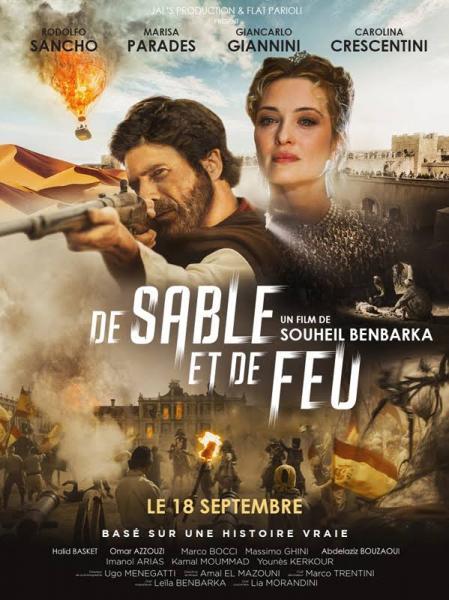
youtube
(This is the English version of the trailer, for the French and the Spanish ones, click in here and here)
The film Sand & Fire (The impossible Dream) tells the story of Domingo Badía i Leblich, alias Ali Bey al Abbassi (April 1st 1767, Barcelona -August 30th 1818, Damascus) and Lady Hester Stanhope, otherwise known as Meleki, Queen of Palmyra, (May 12th 1776 Kent, England - 1839 Djîhoun). Set between 1802 and 1818, the plot of the film has resonance for today with searing realism as it depicts a moderate peaceful Islam confronting another which is fanatical and cruel.
Domingo Badia was a Catalan scientist militar, traveler and Arabist, who in 1803, was commissioned by Manuel Godoy (prime minister of Charles IV of Spain) to undertook a long journey through Muslim territories, camouflaging him as a Syrian prince descendant of the Abbasids, Ali Bey al Abbassi, son of the Emir of Damascus (assassinated by the Otomans).
On the previous tears in Córdoba around 1795 he had been working on his project of the construction of a hot air balloon that he planned to use to carry out atmospheric observations (height of the atmosphere in relation to sea level, atmospheric pressure, heat and humidity), although after several attempts the project did not end with good results.
His travels took him to Morocco, Algeria, Libya and various regions of the Ottoman Empire (Egypt, Arabia, Syria, Turkey and Greece), which he would describe in the book The Travels of Ali Bey, in which along with detailed descriptions of the cities he visited, recorded his observations on geography, botany, zoology, entomology, geology and meteorology.
Although in fact, he was a secret agent with a mission to gain the trust of the Moroccan Sultan, Moulay Slimane and trying to convince him to accept a proposal to stablish the sultanate as a protectorate under the Spanish rule. By then, Badía was conspiring against the sultan, conducting extensive negotiations with the chiefs of the rebellious tribes, to destabilize the sultanate's government and overthrow the sultan, who was suspect of broking his neutralilty and ally with the English against Spain in the context of the Anglo-Spanish War (1804-1809), but the plan failed and Moulay Slimane expelled Ali Bey from the country.
Apart from his travels and his missions in Morocco, during the Napoleonic invasion he acted as mayor of Segovia and prefect of Córdoba between 1809 and 1811 under the rule of Joseph I of Spain.
Within this time period, Richard Brothers (well known for his extremely detailed prediction of the beheading of Louis XVI of France) revealed in a book that Lady Hester Stanhope, niece of the English Prime Minister, William Pitt, would be crowned Queen of Palmyra, the new Zenobia.
Lady Hester was a British aristocrat, but also an adventurer, antiquarian, and one of the most famous travellers of her age. Her archaeological excavation of Ashkelon in 1815 is considered the first to use modern archaeological principles, Her letters and memoirs made her famous as an explorer. She traveled to several places of the Ottoman Empire like Athens, Rhodes, Constantinople, the Ionian Islands, the Peloponnese, Athens, Malta, Constantinople, Rhodes, Egypt, Palestine, Lebanon and Damascus and Jerusalem.
On April 14, 1813, Lady Hester made the decision to charter a caravan of 50 camels, a large retinue of servants and dressed in splendid clothes in the manner of a Druze prince, also hiring a group of armed and uniformed Bedouins as Praetorian Guard. Lady Hester pretended to imitate the mythical queen Zenobia who defied the Romans. On March 29, 1813, the procession arrived at the city of Palmyra, which was splendidly received by the Bedouins. Lady Hester Stanhope earned the admiration and respect of the local Bedouin tribes, who called her Maliki or the White Queen of Tadmir (Palmyra).
Domingo Badia meets Lady Hester when he goes to London on a mission. It is the starting point of a passionate tumultuous love affair which endures for fourteen years before its tragic end; their love unable to sustain two irreconcilable visions of Islam.
Badía died in Damascus in 1818, it is said that he was poisoned by a British agent or that the British ordered to poison him, due to some of his actions during his secret misions were unfavorable for the British, it's said that probably Badía was in a secret mission by that time. Previously he had already frustrated some interventions by the English, such as in 1806 when Badía sabotaged the British plan to remove Mehemet Ali and install their puppet Elfi Bey as pasha of Egypt or when in 1807 in Syria he discovered and destroyed a secret line that the English had to communicate with India.
A film-goer, travelling with Ali Bey through Spain, France, England and Morocco, is transported to sumptuously decorated palaces in Madrid, Paris, London and Morocco of the early 19th century and with Lady Hester to the burning sands of Arabia and the ancient ruins of Palmyra.
The film was shot in Italy, Morocco and England, and it lasts 115 minutes.
After a long absence, Souhail Ben-Barka returned to filmmaking. His career is rich in many films that have marked the history of Moroccan cinema, including the film “Amok” which has won many awards, in addition to his masterpieces “The Battle of the Three Kings”, “The Curse of the Pharaoh” and “The Lovers of Mogador”.
Director's note
I have always had freedom of choice concerning the topics and characters of all my previous films. For this one, I feel designated - as if it has chosen me… With his accomplished seduction, no one can resist the charms of the trickster, The figure full of charisma and mischief, but also the taste for conquest and bluffing of Badia /Ali Bey: From the most humble subjects to the grandest dignitaries, from the Sultan Moulay Slimane, to Lady Hester, Queen of Palmyra, to Napoleon himself who enquires of Talleyrand:
"Your man - is he genius or a madma.?" To which Talleyrand answers.
"A subtle combination of both, Sire. Great men are made that way."
Cast
Rodolfo Sancho (Domingo Badía i Leblich, aka Ali Bay al Abbassi)
Carolina Crescentini (Lady Hester Stanhope, aka Meleki)
Marisa Paredes (Lady Williams)
Giancarlo Giannini (Talleyrand)
Imanol Arias (Sultan Moulay Slimane/ Sulayman of Morocco)
Omar Azzuzi
Massimo Ghini (Amoros)
Marco Bocci (Manuel Godoy)
Abdelaziz Bouzaoui
Younés Kerkour
Hamid Basket
Kamal Moummad (Salem)
Ulisse Provolo (Dott. Blizzard)
Christo Jivkov (Mulai Driss)
Jean-Pierre André Douay
Emanuele Vezzoli (Firmin Didot)
Enrico Salimberi (Napoleon Bonaparte)
Creative staff
Director: Souheil Ben-Barka
Story and Screenplay : Bernard Stora and Souheil Benbarka
Executive Producers: Gianni Sarago and Hamid Basket
Art Director: Amal El Mazouni
Production Designer: Marco Trentini, Francesco Cotone
Director of Photography: Ugo Menegatti
Chief Make Up Artist: Leila Benbarka
Costume Supervisor: Lia Morandini
Music by: Stefano Lentini
Production: Co-production Morocco-Italy: Jal's Production (Casablanca) and Flat Parioli SRL (Rome).
Official website: http://www.desableetdefeu.fr/
Facebook
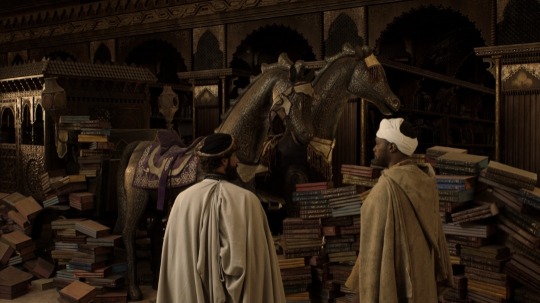








(I have found more pics about the film, but for thid post these are enough)
#de sable et de feu#sabbie e fuoco#sand and fire#el sueño del califa#el sueño envenenado#souheil benbarka#films#period dramas#rodolfo sancho#giancarlo giannini#carolina crescentini#marisa paredes#imanol arias#halid basket#omar azzouzi#marco bocci#massimo ghini#abdelaziz bouzaoui#kamal moummad#younés kerkour#christo jivkov#ulisse provolo#jean-pierre andré douay#domingo badía i leblich#ali bey al abbassi#hester stanhope#meleki of palmyra#slimane of morocco#sulayman of morocco#manuel godoy
9 notes
·
View notes
Text
Marvel Worlds scrap/redux notification #1
Beast
I am a fan of the story planned for this story, but I believe it would be better used in The Wolverine: Heir. Beast and his wife would be now work as S.W.O.R.D..
The series is not officially scrapped as of yet.
Bloodstone
This series was meant to use an idea I had for the scrapped “Marvel Chronicles” universe. I’m not as interested in this character as I once was.
The series is not officially scrapped, but is very close to that.
Cyclops: Age of the Phoenix
This series is scrapped because I’d rather tell stories after the “Dark Phoenix” saga from the comics and be able to use certain characters.
Silver Sable
This series will either be scrapped or redux because Doctor Doom was meant to be the main antagonist and I feel he is too big of an enemy for this series.
Skaar
I often forget about this series and I am not that much interested in the setting or the character of Skaar.
The series is not officially scrapped yet.
Thor
This was meant to have a Thor similar to the one in the MCU film Thor: Love and Thunder. Since the film was not a success and I don’t like comic book Thor I might change the series to be about Kevin Masterson AKA Thunderstrike.
The Wasp
This series is not scrapped, but will be replanned or split in two. I have no interest in the world of fashion and will have to read more about a solo series about Janet. I am a fan of Nadia van Dyne and will tell a story about her either within The Wasp series or in her own solo series.
Witchcraft
The story was meant to focus on Jennifer Kale versus Dormammu. I am not interested in the main character and story.
Wolfsbane & Hrimhari
I made this to use a character I really liked as a teenager but I am not as interested anymore.
0 notes
Text
Geographies of Solitude wins Best Canadian Feature Documentary
Geographies of Solitude film won the Best Canadian Feature Documentary Award at Hot Docs for its experimental portrait of researcher Zoe Lucas and her work on Sable Island.
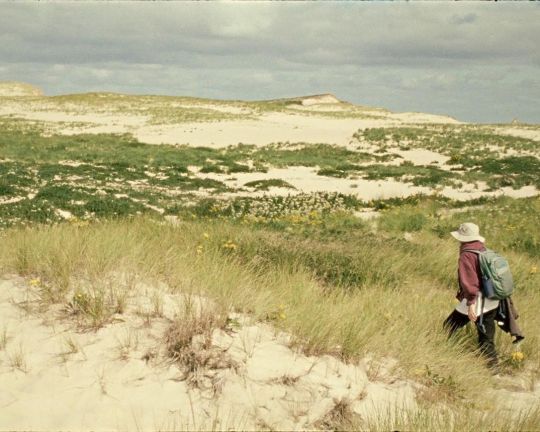
The film is directed by Jacquelyn Mills and produced by Mills and Rosalie Chicoine Perreault. The award includes a cash prize of $10,000, sponsored by Telefilm and the Documentary Organization of Canada.
Hot Docs Winner – Best Canadian Feature Documentary Award
Hot Docs Winner – The Earl A. Glick Emerging Canadian Filmmaker Award
Geographies of Solitude is a film about an environmentalist (Zoe Lucas) living on Nova Scotia's Sable Island has won top Canadian honours at this year's Hot Docs Film Festival 2022 .
Her Sable Island film , "Geographies of Solitude," chronicles the life's work of environmentalist Zoe Lucas, the only full-time inhabitant on Sable Island.
Visual and Aural Storytelling Film
This Sundance supported film is directed by Jacquelyn Mills and produced by Mills and Rosalie Chicoine Perreault. The award includes a cash prize of $10,000, sponsored by Telefilm and the Documentary Organization of Canada.
The jury praised this experimental documentary film Geographies of Solitude for “its deft ability to reveal the complex intersections between the natural world and humanity’s excesses on a singular isolated island through strongly crafted and arresting visual and aural storytelling.”
Mills also won the Earl A. Glick Emerging Canadian Filmmaker Award, which honours an artist presenting their first or second feature at the festival. The award carries a cash prize of $3,000, sponsored by the Glick family.
Geographies of Solitude Trailer
The trailer for "Geographies of Solitude " by Jacquelyn Mills, starring Zoe Lucas.
About the film: For decades, Zoe Lucas has catalogued the flora and fauna on Sable Island, a thin strip of land off the Canadian coast.
Jacquelyn Mills Canadian Experimental Filmmaker
Experimental filmmaker Jacquelyn Mills joins her to observe the sand dunes, freshwater ponds, wild horses and washed-up plastic waste.

This Environmental Documentary Canada was shot on 16mm, the film often incorporates eco-friendly film making techniques to capture, in beautiful effect, Mills' encounters with Zoe Lucas and the Island. In this sense, Zoe Lucas and Sable Island are not “subjects” of the film, but collaborators and co-creators.
We spoke with Jacquelyn Mills to learn more about her intuitive approach in making this Experimental Documentary in Canada and the different ways she worked with her surroundings - including eco-friendly hand processing techniques like using plant emulsion, exposing parts of the film in moonlight and starlight, and placing specimens from Sable Island on film stock.
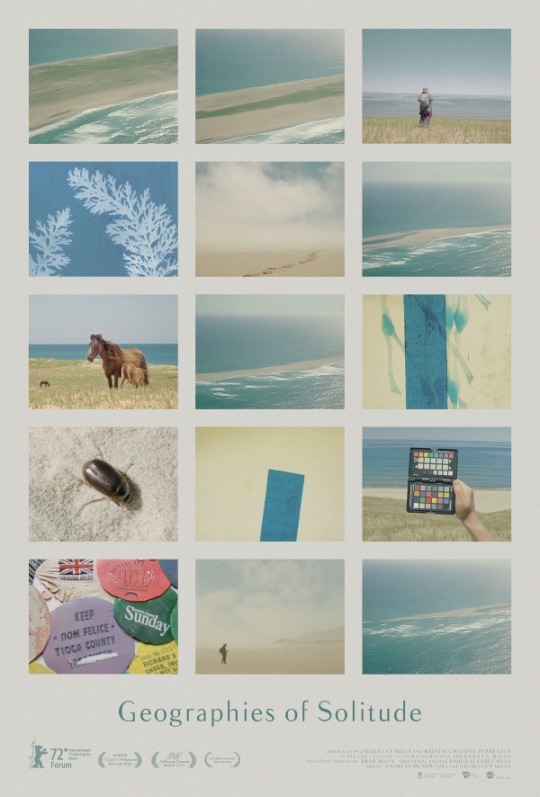
Towards the end of the episode, we speak briefly about her previous film, IN THE WAVES, a touching portrait of the director's grandmother as she grieves the loss of a sister available to stream on Vimeo
ABOUT THE FILM - Geographies of Solitude
Canada, 103 minutes
Director: Jacquelyn Mills Production company: Jacquelyn Mills Executive Producer: Brad Mills International sales: Acéphale [email protected] Producers: Rosalie Chicoine Perreault, Jacquelyn Mills Cinematography: Jacquelyn Mills, Scott Moore Editor: Jacquelyn Mills, Pablo Álvarez-Mesa Sound design: Andreas Mendritzki, Jacquelyn Mills Sound: Jacquelyn Mills Music: Emily Millard, Mark Boudreau Photography: Jacquelyn Mills. Additional Camera: Scott Moore
#Geographies of Solitude#Geographies of Solitude film#sable island film#Nova Scotia filmmaker#Sundance film Canada#Experimental Documentary Canada#Atlantic Canada filmmaker#Environmental Documentary Canada#Nova Scotia film#Cape Breton filmmaker#Best Documentary filmmaker Canada
0 notes
Text
GEOGRAPHIES OF SOLITUDE FILM
The feature debut from Mills, Geographies Of Solitude wins Jeonju’s International Competition, having already taken home the C.I.C.A.E. Art Cinema prize, the Caligari
Film Award and the prize from the Ecumenical Jury following its premiere in Berlin’s Forum. Mill’s previous work includes In The Waves, which premiered at Visions du Réel and was awarded the Grand Jury Prize for Best Medium-Length Documentary. Further festival screenings are likely for Geographies Of Solitude, which as won top prizes as the Best Canadian Documentary Film and Best new Emerging Director in Canada.

Berlinale Forum, 2022, World Premiere
Geographies of Solitude describes in an elegy tone the life of a single inhabitant on an island 100 km from Nova Scotia. This sensation of everything unique is populating the images of a poetics of the unusual, of the foundational, or of the primitive.
Despite all this environment being perceived as Arcadian, where the fauna and flora seem to persist in the face of the vicissitudes of the same winter climate, the off-screen of humans and polluting industries appears painful and inevitable. And it is from this certainty that Zoe Valdez seems to be more alone than ever, in a double condition of hermit and witness of a slow destruction.
Director: Jacquelyn Mills Photography: Jacquelyn Mills. Additional Camera: Scott Moore Edition: Jacquelyn Mills. Additional Editor: Pablo Alvarez-Mesa Sound design: Andreas Mendritzki, Jacquelyn Mills Sound: Jacquelyn Mills filmmaker Producers: Rosalie Chicoine Perreault, Jacquelyn Mills Canada, 106 min., 2022
Prizes won at Berlin Film Festival are as Follows:
Caligari Film Prize
CICAE Art House Cinema Award
Ecumenical Award
Hot Docs: Geographies Of Solitude by Jacquelyn Mills
Jacquelyn Mills’ ‘Geographies of Solitude’ wins Hot Docs’ best Canadian film award
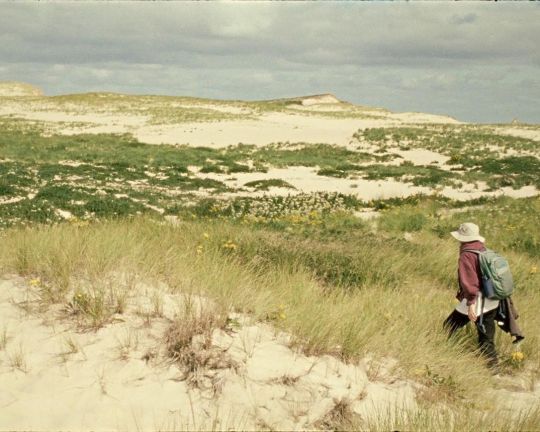
TORONTO - A film about an environmentalist living on Nova Scotia’s Sable Island has won top Canadian honours at this year’s Hot Docs Film Festival.
Director Jacquelyn Mills won the best Canadian feature documentary award and a $10,000 cash prize at a ceremony at Toronto’s TIFF Bell Lightbox on Saturday morning.
Her film, “Geographies of Solitude,” chronicles the life’s work of environmentalist Zoe Lucas, the only full-time inhabitant on Sable Island.
Mills also received the Earl A. Glick emerging Canadian filmmaker award, which is given to a local filmmaker whose film in competition is their first or second feature-length film.
In a statement, the jury praised the film’s “strongly crafted and arresting visual and aural storytelling.“
Hot Docs Winner – Best Canadian Feature Documentary Award Hot Docs Winner – The Earl A. Glick Emerging Canadian Filmmaker Award
Geographies of Solitude won the Best Canadian Feature Documentary Award at Hot Docs for its experimental portrait of researcher Zoe Lucas and her work on Sable Island. The film is directed by Jacquelyn Mills and produced by Mills and Rosalie Chicoine Perreault. The award includes a cash prize of $10,000, sponsored by Telefilm and the Documentary Organization of Canada.
About Zoe Lucas
Zoe Lucas is a self-taught environmentalist and naturalist who has lived for over 40 years on a remote strip of sand. Sable Island is 300 kilometres off the coast of Nova Scotia and can only be reached by private charter plane. This isolated and exposed place has long been recognized for its rare ecosystems with considerable scientific value and importance.
Throughout her decades on Sable Island, as its only full-time inhabitant, Zoe Lucas has demonstrated a scope of research that is staggering in detail. Through her dedication to documenting a life's work—one that accurately mirrors Zoe's work ethic—director Jacquelyn Mills weaves together a meticulous portrait of someone with a remarkable relationship with her surrounding ecosystem. Geographies of Solitude ultimately asks us to consider our own connection to the natural world and the lengths we may need to go to save it.
About This Sable Island Film “Geographies of Solitude”
GEOGRAPHIES OF SOLITUDE is an immersion into the rich ecosystem of Sable Island, guided by naturalist and environmentalist Zoe Lucas who has lived over 40 years on this remote sliver of land in the Northwest Atlantic Ocean.
Shot on 16mm and created using a scope of innovative eco-friendly film-making techniques, this feature-length experimental documentary is a playful and reverent collaboration with the natural world.
Zoe leads us among wild horses, seals and bugs, through peaks, valleys, roots, sands, weathers, seasons and stars. The intangible is evoked with hidden sounds and vanishing light. Much like a field book, the film tracks its protagonist's labor to collect, clean and document marine litter that persistently washes up on the island shores.
#Jacquelyn Mills filmmaker#Geographies of Solitude#Sable Island film#Best Documentary filmmaker Canada#Nova Scotia filmmaker#Sundance film Canada#Experimental Documentary Canada#Atlantic Canada filmmaker#Berlinale Forum films 2022#hot docs toronto#hot docs
0 notes
Photo

©2017-Julia Henderson
#sunshine#island#tropical#dream#rêve#sable#sun#san#white san#sable blanc#plage de rêve#girl#dance#friend#analog#analogic#35mm#film#argentique#photography#colors#couleur#palmier#palm tree#vacances#strasbourg#diamant d'or#squat#party#sea
2 notes
·
View notes
Photo



The Wreck of Nazi Spy-Hunting Ship USRC Bear Discovered
Ocean scientists have located the wreck of the U.S. Revenue Cutter Bear — a ship that served at sea for at least 88 years and played a part in the famous capture of a Nazi spy ship.
The Bear has a storied history: It started working as a commercial sealer in 1874. Then, because the ship could travel through ice-filled waters, the government purchased it in the 1880s to use for rescue work in the Arctic. It also served as a relief ship during the Spanish flu pandemic of 1918-1919, a floating museum, a film set for a Hollywood movie and an expedition ship on Adm. Richard Byrd's Antarctic explorations.
It also patrolled Arctic waters for the U.S. Navy in both world wars, and in 1941 it helped capture the Norwegian trawler Buskø, which was being used by the German military intelligence service Abwehr to report on weather conditions in the North Atlantic.
The Bear was decommissioned in 1944 and tied up at a wharf in Halifax, Nova Scotia. It finally sank after a storm in 1963, somewhere south of Nova Scotia and east of Boston, as it was being towed to Philadelphia.
"The Bear has had such an incredible history, and it's so important in many ways in American and global maritime heritage because of its travels," said Brad Barr, the mission coordinator for the U.S. National Oceanic and Atmospheric Administration's (NOAA) Maritime Heritage Program, who has led the search for the wreck for several years.
Historic ship
In the late 1970s a group started searching for the Bear. It included the Massachusetts Institute of Technology's Harold Edgerton, who invented side-scan sonar — a technology widely used today to detect and image objects on the seafloor.
The group tested out the new side-scan technology in 1979, but they didn't find the wreck — possibly because the location of its sinking had been misreported by its tow ship, Barr said.
A secret Navy submersible — the nuclear-powered NR-1 —— carried out a second search in 2007, but it too was unsuccessful. Finally, the U.S. Coast Guard and NOAA joined forces with other partners and began another search in 2019.
After mapping 62 square miles (160 square kilometers) of seafloor with sonar, they identified two submerged objects in the search area.
In September, they returned on a Coast Guard ship equipped with a remotely operated vehicle (ROV) to take underwater video and confirm that the largest object is the wreck of Bear, Barr said.
The wreck now lies on the seafloor at a depth of about 200 feet (60 meters), in Canadian waters about 90 nautical miles (167 km) south of Nova Scotia's Cape Sable. The exact location is being kept confidential in the hopes of deterring technical divers from trying to reach it, Barr said. The search partners are discussing with the Canadian government how the wreck can be protected.
The aging wooden hull has been badly damaged by nets from fishing trawlers and strong currents on the seafloor. But the researchers identified several distinctive features of the Bear, including the "bow staples" that strengthened its hull to allow the ship to handle heavy ice in polar waters, Barr said.
Steamship to diesel
Although the Bear was equipped with three masts for sailing, it was built as a steamship for its role as a sealer in the 1870s. In the 1930s, the boiler was taken out and the steam engine replaced with a diesel engine as it was refitted for its Antarctic service with Byrd.
As a result, several piles of metal can be seen among the remaining wood of the wreck, which includes sailing-ship technologies, Barr said.
"There's a pile of metal rubble with a deadeye [a fixed wooden pulley] sticking up out of it," he said. "These deadeyes have been around since the 1700s, but they were used on the Bear to attach the standing rigging."
Among the Bear's most famous exploits was its part in the 1884 rescue fleet for the Greely Expedition to the Arctic, which had become lost in 1881 near Ellesmere Island, northwest of Greenland. Several members of the expedition died of starvation and disease before the Bear rescued Greely and the other survivors.
After serving for many years as a government revenue cutter in Arctic waters — intercepting and inspecting ships at sea, and often rescuing commercial ships trapped in ice — the Bear was transferred to the Navy; it patrolled around Alaska during World War I, and it delivered supplies there during the Spanish flu pandemic.
In 1929, the decommissioned ship was given to the city of Oakland in California, where it became a floating museum and then a film set for the 1930 movie "The Sea-Wolf," an adaption of a Jack London novel.
The Bear was recommissioned for Arctic patrols during World War II, when it helped capture the Buskø; but it was mostly tied up in Halifax after that, until it sank in 1963 on its final voyage to Philadelphia, where it was destined to become a floating restaurant.
"These are incredibly compelling stories," Barr said. "When you read the details of what the Bear did, how many lives it saved, how many incredible missions it was on — it is really the kind of history that people should be aware of."
To commemorate its discovery, Barr has compiled years of historical research into several website posts detailing the many exploits of the Bear. "One of the reasons why we wanted to find it is because it allows us to tell all these stories," he said.
By Tom Metcalfe.
#The Wreck of Nazi Spy-Hunting Ship USRC Bear Discovered#Norwegian Trawler Buskø#Historic Ship#WW2#histoey#history news
5 notes
·
View notes
Text
Les meilleurs circuits et les choses à faire à Hawaii
Son eau turquoise, ses surfeurs, ses palmiers, ses paysages dignes des plus grands films romantiques... l'archipel hawaïen fait rêver plus d'un. Et lorsque vous décidez de partir à l'aventure, il est préférable de ne pas manquer l'organisation du voyage qui sera sûrement l'un des plus beaux de votre vie ! Ce petit bijou de l'océan Pacifique ne vous laissera pas indifférent... Découvrez avec nous les 6 choses à faire sur l'île d'Oahu !
1. Visite de la plage du North Shore - Oahu
Le merveilleux North Shore Beach Tour permet aux voyageurs de quitter Waikiki et de se rendre à Hale'iwa, sur Hawaï les endroits préfères, pour une journée entière d'aventure au soleil et au surf. Découvrez l'histoire du surf parmi la royauté hawaïenne, et visitez les spots de surf les plus célèbres du monde, Banzai Pipeline et Waimea Bay, avec une eau suffisamment claire pour voir le fond et un énorme rocher pour sauter la falaise. Les visiteurs sont invités à y nager, surfer, faire de la plongée libre, du canoë ou de la plongée sous-marine. À pua'ENA point, vous pourrez faire de la plongée libre avec des tortues de mer, avant de vous rendre sur la rivière Wailua pour faire du stand-bobard et raser la glace. Terminez par un voyage à la plantation de Dole pour une glace à l'ananas. Le déjeuner à la ferme de Tsue est inclus. Tous les âges sont les bienvenus.

2. Visite en hélicoptère de Doors-Off - Kauai
Environ 70 % de la magnifique région de Kauai est inaccessible à pied ; la seule façon de tout voir est de prendre l'hélicoptère, et en volant sans les portes, on peut profiter d'une vue imprenable. Des paysages à couper le souffle entourent les visiteurs, notamment la côte Na Pali, le canyon Waimea, le mont Waialeale et les chutes du Jurassique. Pour les excursions avec portes fermées, les passagers doivent être âgés d'au moins dix ans. Ils proposent des circuits avec portes ouvertes (et climatisation) qui conviennent aux plus jeunes ; cependant, cela peut se révéler être une sieste coûteuse pour les petits ! Les excursions durent 60 ou 90 minutes au total ; prévoyez du temps supplémentaire pour les consignes de sécurité et le transport vers et depuis les hélicoptères (fournis par la compagnie). Au départ de Lihue, Jack Harter Helicopters se trouve à proximité de la plage de Kalapaki et des excursions en turbin de Backcountry Adventures.

3. Manta Ray Night Dive and Snorkel EcoAdventure - Big Island
Notre agence aide les clients à s'approcher de ces doux géants, d'une envergure moyenne de douze pieds. Au coucher du soleil, les bateaux quittent la côte de Kona pour le lieu de rassemblement au large de centaines de rayons. Les raies Mantas sont attirées dans la zone par des lumières que les clients gardent allumées, et elles font des signes et se déplacent à la recherche de plancton à quelques centimètres des plongeurs. Il n'y a pas de restriction d'âge, mais il est recommandé d'avoir six ans et plus. Le circuit de trois heures part de la marina d'Honokohau, près de la plage de surf Pine Trees et de la ferme Ocean Rider Seahorse, ce qui en fait une fin parfaite pour une journée de soleil, de sable et de nature.

4. Tour de la lave au lever du soleil - Big Islande
Notre agence organise une spectaculaire randonnée guidée pour visiter les coulées de lave en activité. En commençant dans le parc national des volcans, les visiteurs peuvent s'approcher à quelques mètres de la lave fraîche, admirer le lever du soleil et visiter des zones moins connues du parc de la forêt tropicale. Une collation, de l'eau et des ponchos de pluie sont fournis. La randonnée est longue, environ quatre à cinq miles dans chaque direction, selon l'activité volcanique en cours. Il n'y a aucune restriction d'âge, mais la randonnée peut être trop fatigante pour de très jeunes enfants. De plus, les vapeurs volcaniques sont fortes ; il est conseillé aux femmes enceintes, aux nourrissons et aux personnes âgées de ne pas s'approcher d'aussi près. Les visites commencent à 4 heures du matin et se terminent entre 9 et 10 heures, selon la proximité de la lave qui coule ce jour-là.

5. Na Pali Sunset Dinner Sail - Kauai
Les voiles du catamaran du capitaine Andy offrent des vues spectaculaires sur la côte accidentée de Na Pali. Les falaises abruptes et déchiquetées, les rencontres avec les dauphins, la vie marine et les couleurs du coucher de soleil en font un excellent choix pour une soirée romantique à deux. Un excellent dîner avec cocktails inclus. Les bateaux partent d'Ele'ele et durent quatre heures. Arrêtez-vous à la route pour un vol de bières locales, car la nourriture et les cocktails sur le bateau ne sont servis que quelques heures après le départ.

6. Molokini Express, Adventure Snorkeling - Maui
Notre agence propose l'une des excursions de plongée en apnée les plus courtes et les plus abordables au départ de Maui vers les eaux cristallines du Molokini, un cratère volcanique et un sanctuaire d'oiseaux marins. Les radeaux gonflables sont petits et maniables, capables de s'approcher très près des falaises plongeantes. C'est une expérience incroyable de plongée en apnée dans des zones où les gros bateaux ne peuvent pas passer, avec des poissons tropicaux partout et plus d'une heure passée dans l'eau. Le clou du voyage, cependant, est la balade elle-même, car le minuscule bateau prend de l'air, sautant par-dessus les vagues. Les enfants de quatre ans et plus sont les bienvenus ; les enfants plus jeunes sont autorisés à bord des charters privés. La visite dure deux heures au total et part de la rampe de navigation de Kihei, près du refuge national de la faune sauvage de l'étang de Kealia, qui abrite des oiseaux des zones humides menacées, et de la brasserie Maui Brewing Company, avec une salle de dégustation et des visites de brasseries.

1 note
·
View note
Text
0 notes
Text
Cinema Guild Acquires Jacquelyn Mills‘ Berlin Prize-Winning Doc ’Geographies Of Solitude’
Cinema Guild Acquires Jacquelyn Mills‘ Berlin Prize-Winning Doc ’Geographies Of Solitude’
EXCLUSIVE: Cinema Guild has picked up U.S. rights to the Jacquelyn Mills-directed Berlin prize winner Geographies of Solitude with plans to open the documentary in theaters next year, beginning with a run at New York City’s Anthology Film Archives from January 25- 31. An immersion into the rich ecosystem of Sable Island, a remote sliver of land in the Northwest Atlantic, the film follows Zoe…
View On WordPress
0 notes
Text
Geographies of Solitude Film
Geographies of Solitude Film wins Best Canadian Documentary!
Winner "Best Canadian Feature Documentary Award" Hot Docs Winner "The Earl A. Glick Emerging Canadian Filmmaker Award"
Geographies of Solitude is a film about an environmentalist (Zoe Lucas) living on Nova Scotia's Sable Island has won top Canadian honours at this year's Hot Docs Film Festival 2022.
Geographies of Solitude Trailer
The trailer for "Geographies of Solitude " by Jacquelyn Mills, starring Zoe Lucas.
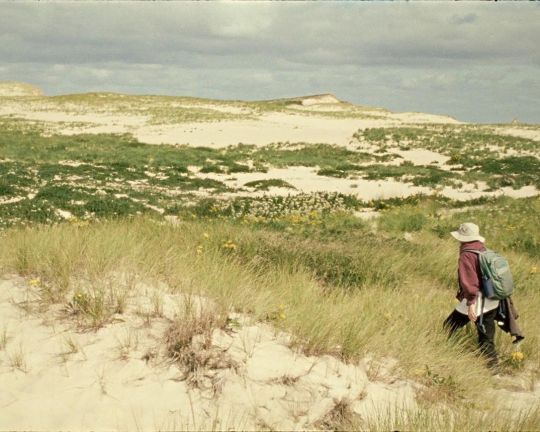
About the film
For decades, Zoe Lucas has catalogued the flora and fauna on Sable Island, a thin strip of land off the Canadian coast. Jacquelyn Mills is the Canadian Experimental Filmmaker for Geographies of Solitude.
Mixing vivid 16mm footage with hand-processed abstractions, Jacquelyn Mills's film, a multiple prizewinner at the recent Berlinale, is a portrait of conservationist Zoe Lucas, one of the lone inhabitants of Sable Island, a 26-mile sandbar off the coast of Nova Scotia.
This Sundance supported Canadian film is directed by filmmaker Jacquelyn Mills and produced by Mills and Rosalie Chicoine Perreault. The award includes a cash prize of $10,000, sponsored by Telefilm and the Documentary Organization of Canada. The jury praised this experimental documentary film Geographies of Solitude for "its deft ability to reveal the complex intersections between the natural world and humanity's excesses on a singular isolated island through strongly crafted and arresting visual and aural storytelling."
Geographies of Solitude
Jacquelyn Mills’ Sable Island film "Geographies of Solitude," chronicles the life's work of environmentalist Zoe Lucas, the only full-time inhabitant on Sable Island.

Mills also won the Earl A. Glick Emerging Canadian Filmmaker Award, which honours an artist presenting their first or second feature at the festival. The award carries a cash prize of $3,000, sponsored by the Glick family. Geographies of Solitude Trailer. An account of Lucas's remarkable study of the island's biodiversity, its fabled herds of wild horses, and the many ecological threats it faces, Geographies of Solitude is also a sensuous collaboration between filmmaker, subject, and the sparse, windswept terrain.
0 notes
Text
Jacquelyn Mills' 'Geographies of Solitude' Wins Hot Docs Best Canadian Film Award
Jacquelyn Mills’ ‘Geographies of Solitude’ Wins Hot Docs Best Canadian Film Award
TORONTO — A film about an environmentalist living on Sable Island, Nova Scotia, won top Canadian honors at this year’s Hot Docs Film Festival. Director Jacquelyn Mills picked up the award for best Canadian feature film and a cash prize of $10,000 during a ceremony at Toronto’s TIFF Bell Lightbox on Saturday morning. Her film, “Geographies of Loneliness,” chronicles the lifelong work of…

View On WordPress
0 notes
Photo

Beast Video Production
Storytelling is critical when it comes to creating engaging video content. It allows you to move away from explicit, product-driven promotion and toward a more subtle approach. People who watch the first three seconds of a video will watch it for at least 30 seconds, according to Facebook's video consumption statistics research. Because you don't have any real-time visual clues to measure your audience's reaction, your best hope is to get to know them and look for signs of engagement. That’s why it is important to partner with the right video agency that has the right expertise to help you reach your goals
The image of our clients is important to us, and we work hard to improve it. Beast is a multi-award-winning firm based in London that is always striving to develop and achieve success. Because we are a production company and a video agency, we can provide both creative and filmmaking services. Beast's members are skilled and uniquely qualified individuals that create incredible, engaging material.
Looking For video production company
Services
For many firms, the digital web platform is a vast sea of uncharted waters. Nonetheless, the chances to reach new audiences are enormous, making the challenge all the more fascinating.
Below we are including just some of the endless video creation services we provide at Beast:
● Animation Videos
○ We offer 2D and 3D animation. Our Animation Directorial team has incredibly talented writers, animators and compositors.
● Branded Content Videos
○ Our London branded agency is known for creating and filming to the same level as broadcast TV commercials.
● Promotional Videos
○ Our directors are experts in finding unique ways to make a promotional video attractive and memorable.
● Training Videos
○ To make even the most basic video aesthetically fascinating, we strive to produce wonderfully crafted shots.
● Luxury Travel Videos
○ Travel movies can be a lot of fun. We provide stunning results with a high production value with our range of equipment.
● Event Videos
○ After the event, event clips are a terrific method to connect out to your audience. To make them entertaining, you'll need experts with a specific level of creativity in filmmaking and storytelling.
Reviews
In this section, we are including some of our written reviews from our past clients. Feel free to check more on our website.
By: Trevor Healey, Creative Director, Mr.H
“With a successful shoot for our Cayman Island Tourist Office behind us, I have no hesitation in saying that Beast’s film-making and storytelling skills are outstanding. We asked them to capture the languid, sun-soaked atmosphere, the relaxed sophistication, the barefoot luxury and the romance of the islands – and they absolutely nailed it.”
By: Paul Doran, CEO, Switchcoms
“Beast really impressed me with their ability to turn a business need into a creative and visual story. The online world is full of too much, often poor content. So working with Beast helped us gain a huge amount of positive conversation.”
Awards
Beast has won numerous awards in different competitions from the projects that we took under our belt. Some of these awards can be seen below:
• Cannes Lions 2018 BRONZE: Burger King “Whopper No Show”
• Vimeo Staff Picks: Eunoia
• Vimeo Staff Picks: Sable Noir
• Vimeo Staff Picks: Afraid of the Dark
• London Brand Film Awards 2017 BRONZE: Cambridge Audio “British Sound”
• Cannes Lions Shortlist: MS “Earthquake”
• Cannes Lions Shortlist: NSPCC “Hide & Seek”
Case Study
At Beast, we guarantee that you will find high-quality work within less time. Our past gigs consistently bring back excellent results.
Below is a quick description of one of our recent projects
BRIEF: Create advertisements to be used by an office equipment company
• Deliverables: Create 3-30sec videos to be used on ads online
• Result - 3000% increase in website traffic
0 notes
Text
Epic Movie (Re)Watch #191 - 20,000 Leagues Under The Sea (1954)
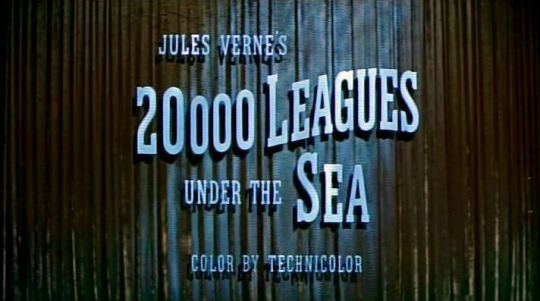
Spoilers Below
Have I seen it before: Yes
Did I like it then: I think so.
Do I remember it: More or less.
Did I see it in theaters: No.
Format: DVD
1) According to IMDb:
Richard Fleischer was surprised at being considered for the director's chair for this film, as he was the son of Disney's biggest competitor, Max Fleischer. He approached Walt Disney to inquire if Disney knew who he was. Disney told him that he was well aware of who he was and hired him because he thought he was the best man for the job. Richard Fleischer also asked his father if he minded having his son working for his rival but Max Fleischer made no objection and even asked Richard to tell Disney that he thought he had made an excellent choice for his director!
Just some fun trivia to start with.
2) This film’s brief opening explosion does quite well to establish the danger of the seas and some of the film’s stakes.
3) Kirk Douglas as Ned Land.

Douglas plays land as a traditional roguish action hero in the best sense. He has this wonderful sense of humor and charm, playing a character who could’ve easily been a hated jackass as someone you like/root for. He’s lovably devious and just fun.
4) I know this movie is from 1954, but quite calling anything that you consider the east, “the orient!”
5) Paul Lukas as Professor Aronnax.
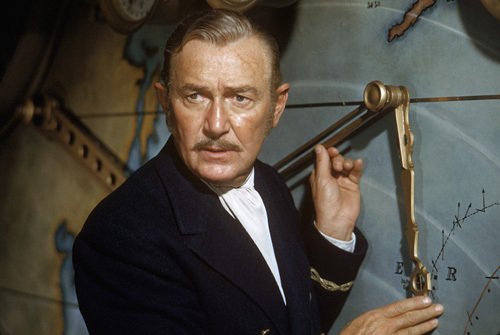
Lukas plays Aronnax as a remarkably patient and considerate character. You invest in him easily because he’s reasonable, curious, soft spoken, and just genuinely kind. The performance is what makes the character here and it’s great.
6) The film really takes advantage of its oceanic setting with brief moments of spectacle, featuring grand shots of dolphins and whales in real life. Although unfortunately this can come at the expense of pacing.
7) “A Whale of a Tale”
youtube
While this song serves mainly as an extended distraction from the plot & an opportunity to let Kirk Douglas sing a song, it’s just incredibly fun too. It’s a classic of the Disney canon, appearing on Classic Disney: Vol. 1 (albeit with a different third verse), and even getting a reference in Finding Nemo. All in all, it’s just a standout moment of the film.
8) There’s a nice sense of tension in the skirmish between the ship and the “monster” before Ned, Aronnax, and Conseil (Aronnax’s assistant) fall into the water.
9) So, because it’s 2017 and I’m a sucker for gay ships, I head canon that Conseil is in love or has feeling for Aronnax. He jumps into the water without a second thought when the professor falls in and the entire time on the Nautilus he is very adamant about not leaving without the professor. It’s most likely intended as loyalty from an assistant to his professor, but my way is more fun.

10) The Nautilus.
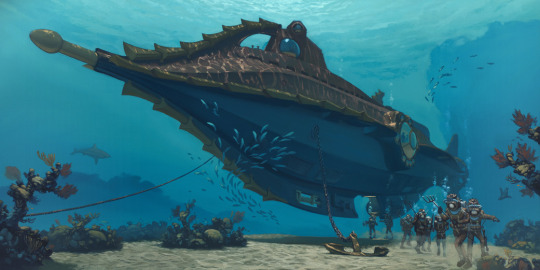
(This is just concept art but it’s the best visual representation I could find.)
The wonder which the film gives the steam punk submarine upon simply realizing what it is helps make the vessel seem miraculous even in a world where submarines exist. The further exploration of the Nautilus helps establish a sense of place and geography to the vessel, while the visual design is also wildly imaginative/spectacular. This is all incredible important as the Nautilus is as important a character to the story as Nemo or Ned, in some ways more so. So the fact the film puts os much stock into the Nautilus just shows the filmmakers understand it.
11) James Mason as Captain Nemo.
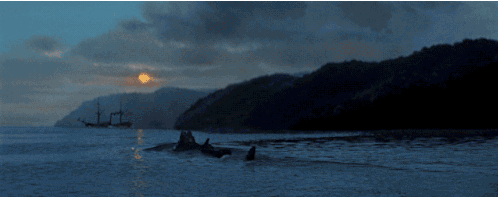
Unfortunately Mason’s casting as the iconic character is part of a long line of Hollywood white washing, since in the source material Captain Nemo is the son of an Indian Raja. This effects some of how Nemo’s backstory comes across (who held him in slavery? Why? I don’t really get that part of the movie, just that he lost his family because of it), but Mason is very strong in the part. He breathes incredible complexity, intelligence, interest and power into the captain of the Nautilus. Which is important as Nemo is one of the most complicated and complex antiheroes every to appear in fiction. Within a few moments Mason is sable to establish that Nemo has these complexities, that there’s so much to him we don’t see, with just his performance.
Nemo is filled with contradictions. He makes a point about how he is not civilized but gives Ned a hard time for not using a fork. He criticizes Ned for going after treasure when Nemo has a whole closet full of it. And while he uses his pain to justify the murder of countless sailors to stop war from spreading, are they not as innocent as his family? I thought they didn’t know what they were carrying, but are instead the same people who we see getting whipped like Nemo once was a slave.
But more than anything else Mason is able to show us a lot of Nemo when he’s not speaking a word. We see his intense pain at times when playing the pipe organ and we understand just how deeply he loves the seas. How it calms him, how it is his paradise. While the whitewashing of the character is more than unfortunate, Mason still does a strong job in the part.
12) Nemo’s pipe organ can actually seen by the general public and not in a museum. It currently resides in Disneyland’s Haunted Mansion ride and has done so since 1969.

13) The hunting expedition sequence is another showcase of how the film will often place wonder over pacing. The scene is incredible, with visually compelling elements and unique action. The finding of the sunken treasure is especially nice, as is the ensuing shark attack. But it’s just so freaking slow.
14) Oh, professor…
Aronnax [about Ned]: “His life means nothing! Nor does mine or yours compared to what’s behind all this.”
I disagree, but whatever. i think I’m meant to.
15) I mentioned this before, but I don’t fully understand Nemo’s backstory. He calls the island prison a, “white man’s grave.” Does that mean this film is trying to tell us non-white people are kidnapping white men and using them as slaves? That’s a fucked up narrative device and makes me wonder (as someone who’s never read the book) how this all fits with Nemo’s original heritage.
16) When Arronax says Nemo is, “not only a murderer but a hypocrite,” that was when I learned what the word hypocrite means.
16.1) I would also like to point out taking life is always much easier than maintaining it. There was probably another solution to Nemo’s problem of war spreading other than killing sailors over and over again, but death is much easier.
17) Ah, the racist and outdated “dangerous natives” trope. Yeah, please let this die soon.
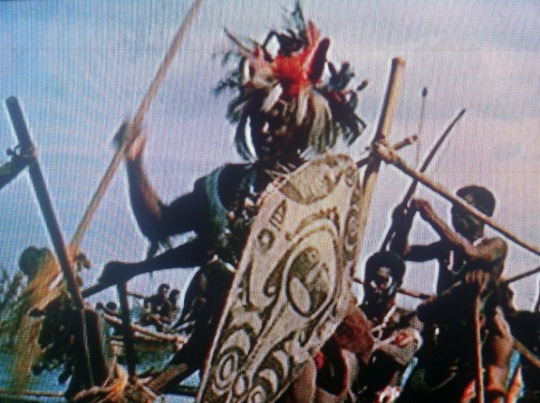
And these cannibals are the only fucking black people in the movie. And they’re all dudes, of course. The only two women in this movie were Ned’s girlfriends from before. This whole part of the movie just makes me sad.
18) The Nautilus sinking is actually an excellent example of stakes in the film. There is an incredible tension and pressure throughout where the slower pacing is actually beneficial.
19) THE GIANT SQUID!!!!

This is the best damn part of the entire film, honestly. The fight with the giant squid has become wildly iconic and brings an incredible sense of fun that is born out of incredible imagination. There is strong action, stakes, and pacing throughout. While the practical effects are crazy strong, especially for the time. 63 years later and you’re not pulled out of the scene. Kirk Douglas even gets a real action hero moment to shine when he kills the beast. All in all, it’s just great.
20)
Nemo [after Ned saves him from the squid]: “Mr Land, you saved my life. Why?”
Ned [after a beat]: “That’s a good question.”

21) Honestly the giant squid works as a better climax for the movie than Nemo blowing up his island based. It is the greatest moment of tension in the film, far more so than what we get on Volcania. HOWEVER, the ending on Volcania is a much more fitting emotional conclusion. This story could only have ended one way and that is with the death of Captain Nemo.
22) Oh thank god, they save the seal! I was worried about that.
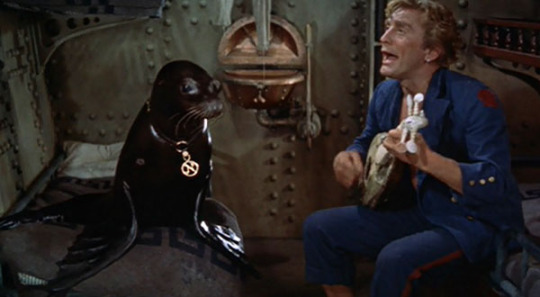
23) Okay, so one final thought. Everyone is like, “we have to get off the Nautilus before the explosion of Volcania goes off and kills us all!” But then the island blows up and it’s nowhere near Nautilus.

While an unfortunate example of white washing and problematic handling of non-white characters, 20,000 Leagues Under the Sea is still in many ways a classic. It can drag at some points but Mason commands as Nemo, the design and imagination that went into the film is clear, there are a nice amount of fun moments, and then the giant squid is awesome! Especially if you’re a Disney fan, a fan of the book, or a sci-fi fan in general, you should watch this film. If you’re not those things you still might want to give this movie a try. See if you like it.
#20000 Leagues Under the Sea#Twenty Thousand Leagues Under the Sea#James Mason#Kirk Douglas#Disney#Peter Lorre#Paul Lukas#Richard Fleischer#I Don't Get It#Epic Movie (Re)Watch#Movie#Film#GIF#The More You Know
11 notes
·
View notes